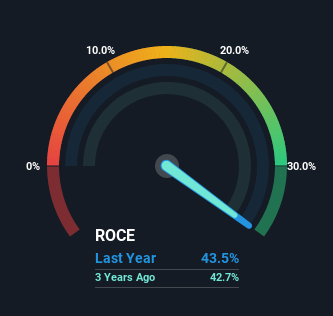Returns On Capital Are A Standout For Nongfu Spring (HKG:9633)

If you're looking for a multi-bagger, there's a few things to keep an eye out for. Amongst other things, we'll want to see two things; firstly, a growing return on capital employed (ROCE) and secondly, an expansion in the company's amount of capital employed. If you see this, it typically means it's a company with a great business model and plenty of profitable reinvestment opportunities. So when we looked at the ROCE trend of Nongfu Spring (HKG:9633) we really liked what we saw.
What Is Return On Capital Employed (ROCE)?
For those who don't know, ROCE is a measure of a company's yearly pre-tax profit (its return), relative to the capital employed in the business. To calculate this metric for Nongfu Spring, this is the formula:
Return on Capital Employed = Earnings Before Interest and Tax (EBIT) ÷ (Total Assets - Current Liabilities)
0.44 = CN¥9.0b ÷ (CN¥39b - CN¥18b) (Based on the trailing twelve months to June 2022).
Thus, Nongfu Spring has an ROCE of 44%. In absolute terms that's a great return and it's even better than the Beverage industry average of 9.7%.
Our analysis indicates that 9633 is potentially overvalued!

In the above chart we have measured Nongfu Spring's prior ROCE against its prior performance, but the future is arguably more important. If you'd like to see what analysts are forecasting going forward, you should check out our free report for Nongfu Spring.
What Does the ROCE Trend For Nongfu Spring Tell Us?
Nongfu Spring is displaying some positive trends. The data shows that returns on capital have increased substantially over the last four years to 44%. The company is effectively making more money per dollar of capital used, and it's worth noting that the amount of capital has increased too, by 58%. This can indicate that there's plenty of opportunities to invest capital internally and at ever higher rates, a combination that's common among multi-baggers.
For the record though, there was a noticeable increase in the company's current liabilities over the period, so we would attribute some of the ROCE growth to that. Essentially the business now has suppliers or short-term creditors funding about 46% of its operations, which isn't ideal. And with current liabilities at those levels, that's pretty high.
The Bottom Line On Nongfu Spring's ROCE
In summary, it's great to see that Nongfu Spring can compound returns by consistently reinvesting capital at increasing rates of return, because these are some of the key ingredients of those highly sought after multi-baggers. Since the stock has returned a solid 17% to shareholders over the last year, it's fair to say investors are beginning to recognize these changes. Therefore, we think it would be worth your time to check if these trends are going to continue.
On the other side of ROCE, we have to consider valuation. That's why we have a FREE intrinsic value estimation on our platform that is definitely worth checking out.
If you'd like to see other companies earning high returns, check out our free list of companies earning high returns with solid balance sheets here.
Valuation is complex, but we're here to simplify it.
Discover if Nongfu Spring might be undervalued or overvalued with our detailed analysis, featuring fair value estimates, potential risks, dividends, insider trades, and its financial condition.
Access Free AnalysisHave feedback on this article? Concerned about the content? Get in touch with us directly. Alternatively, email editorial-team (at) simplywallst.com.
This article by Simply Wall St is general in nature. We provide commentary based on historical data and analyst forecasts only using an unbiased methodology and our articles are not intended to be financial advice. It does not constitute a recommendation to buy or sell any stock, and does not take account of your objectives, or your financial situation. We aim to bring you long-term focused analysis driven by fundamental data. Note that our analysis may not factor in the latest price-sensitive company announcements or qualitative material. Simply Wall St has no position in any stocks mentioned.
About SEHK:9633
Nongfu Spring
Researches, develops, produces, and markets packaged drinking water and beverage products primarily in Mainland China.
Solid track record with adequate balance sheet.


